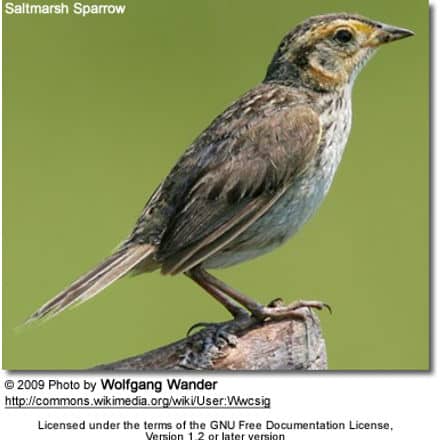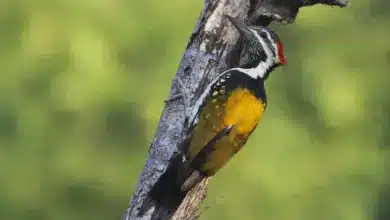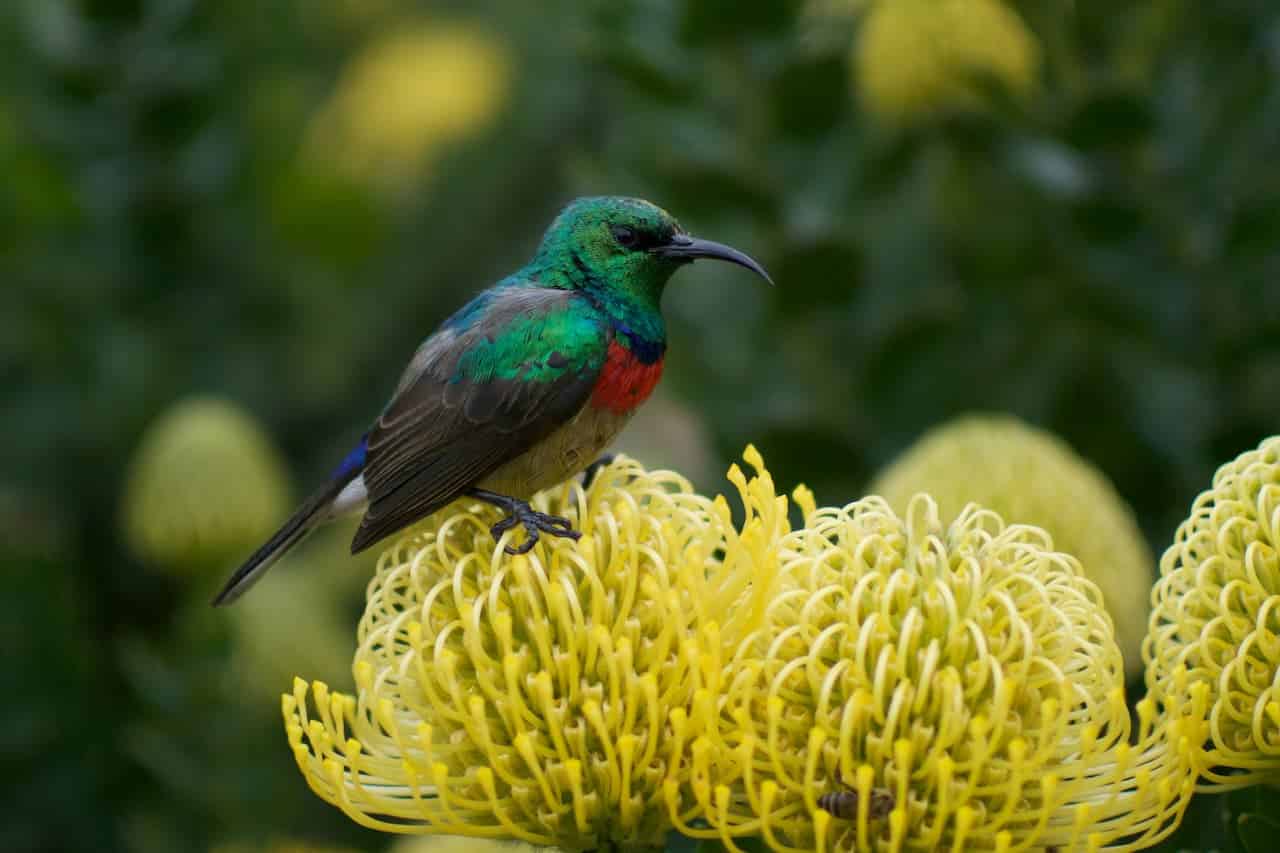Saltmarsh Sparrows (Ammodramus caudacutus)
The Saltmarsh Sparrows, Ammodramus caudacutus, is a small sparrow. At one time, this bird and the Nelson’s Sparrow were thought to be a single species, the Sharp-tailed Sparrow. Because of this, the species was briefly known as “Saltmarsh Sharp-tailed Sparrow”.


Description
Adults have brownish upperparts with grey on the crown and nape, a cream-colored breast with dark streaks and a white throat and belly; they have an orange face with grey cheeks and a short pointed tail..
Distribution / Range
Their breeding habitat is salt marshes on the Atlantic coast of the United States from southern Maine to Virginia.
These birds migrate further south along the eastern coast of the United States.
This bird’s numbers are declining due to habitat loss.
Breeding / Nesting
The nest is an open cup located above the high tide line. Males compete for females but do not defend territories. Only females raise the young.
Diet / Feeding
They forage on the ground or in marsh vegetation, sometimes probing in mud. They mainly eat insects, aquatic invertebrates and seeds..
Call / Vocalization
The call is a raspy trill.
References
- BirdLife International (2004). Ammodramus caudacutus. 2006 IUCN Red List of Threatened Species. IUCN 2006. Retrieved on 11 May 2006. Database entry includes a range map and justification for why this species is vulnerable
Further reading
Book
- Greenlaw, J. S. and J. D. Rising. 1994. Sharp-tailed Sparrow (Ammodramus caudacutus). In The Birds of North America, No. 112 (A. Poole and F. Gill, Eds.). Philadelphia: The Academy of Natural Sciences; Washington, D.C.: The American Ornithologists’ Union.
Articles
- Benoit LK and Askins RA. (1999). Impact of the spread of Phragmites on the distribution of birds in Connecticut tidal marshes. Wetlands. vol 19, no 1. p. 194-208.
- Benoit LK and Askins RA. (2002). Relationship between habitat area and the distribution of tidal marsh birds. Wilson Bulletin. vol 114, no 3. p. 314-323.
- Chan YL, Hill CE, Maldonado JE and Fleischer RC. (2006). Evolution and conservation of tidal-marsh vertebrates: Molecular approaches. Studies in Avian Biology. vol 32, p. 54-75.
- Conway CJ and Droege S. (2006). A unified strategy for monitoring changes in abundance of birds associated with North American tidal marshes. Studies in Avian Biology. vol 32, p. 282-297.
- DiQuinzio DA, Paton PWC and Eddleman WR. (2001). Site fidelity, philopatry, and survival of promiscuous Saltmarsh Sharp-tailed Sparrows in Rhode Island. Auk. vol 118, no 4. p. 888-899.
- DiQuinzio DA, Paton PWC and Eddleman WR. (2002). Nesting ecology of saltmarsh sharp-tailed sparrows in a tidally restricted salt marsh. Wetlands. vol 22, no 1. p. 179-185.
- Erwin RM, Cahoon DR, Prosser DJ, Sanders GM and Hensel P. (2006). Surface elevation dynamics in vegetated Spartina marshes versus unvegetated tidal ponds along the mid-Atlantic coast, USA, with implications to waterbirds. Estuaries and Coasts. vol 29, no 1. p. 96-106.
- Erwin RM, Sanders GM and Prosser DJ. (2004). Changes in lagoonal marsh morphology at selected northeastern Atlantic coast sites of significance to migratory waterbirds. Wetlands. vol 24, no 4. p. 891-903.
- Erwin RM, Sanders GM, Prosser DJ and Cahoon DR. (2006). High tides and rising seas: Potential effects on estuarine waterbirds. Studies in Avian Biology. vol 32, p. 214-228.
- Fry AJ. (1999). Mildly deleterious mutations in avian mitochondrial DNA: Evidence from neutrality tests. Evolution. vol 53, no 5. p. 1617-1620.
- Gjerdrum C, Elphick CS and Rubega M. (2005). Nest site selection and nesting success in Saltmarsh breeding sparrows: The importance of nest habitat, timing, and study site differences. Condor. vol 107, no 4. p. 849-862.
- Greenlaw JS. (1993). Behavioral and morphological diversification in sharp-tailed sparrows (Ammodramus caudacutus) of the Atlantic coast. Auk. vol 110, no 2. p. 286-303.
- Grenier JL and Greenberg R. (2006). Trophic adaptations in sparrows and other vertebrates of tidal marshes. Studies in Avian Biology. vol 32, p. 130-139.
- Hanowski JM and Niemi GJ. (1990). An Approach for Quantifying Habitat Characteristics for Rare Wetland Birds. In Mitchell, R S, C J Sheviak and D J Leopold (Ed) New York State Museum Bulletin, No 471 Ecosystem Management: Rare Species and Significant Habitats; 15th Annual Natural Areas Conference and 10th Annual Meeting of the Natural Areas Association, Syracuse, New York, USA, June 6-9, 1988 Ix+314p New York State Museum: Albany, New York, USA Illus Maps Paper 51-56, 1990.
- Hodgman TP, Shriver WG and Vickery PD. (2002). Redefining range overlap between the Sharp-tailed Sparrows of coastal New England. Wilson Bulletin. vol 114, no 1. p. 38-43.
- Patten MA and Radamaker K. (1991). A Fall Record of the Sharp-Tailed Sparrow for Interior California USA. Western Birds. vol 22, no 1. p. 37-38.
- Post W. (1998). The status of Nelson’s and saltmarsh sharp-tailed sparrows on Waccasassa Bay, Levy County, Florida. Florida Field Naturalist. vol 26, no 1. p. 1-6.
- Post W and Greenlaw JS. (2006). Nestling diets of coexisting salt marsh sparrows: Opportunism in a food-rich environment. Estuaries and Coasts. vol 29, no 5. p. 765-775.
- Rising JD and Avise JC. (1993). Application of genealogical-concordance principles to the taxonomy and evolutionary history of the sharp-tailed sparrow (Ammodramus caudacutus). Auk. vol 110, no 4. p. 844-856.
- Shriver WG, Gibbs JP, Vickery PD, Gibbs HL, Hodgman TP, Jones PT and Jacques CN. (2005). Concordance between morphological and molecular markers in assessing hybridization between sharp-tailed sparrows in New England. Auk. vol 122, no 1. p. 94-107.





